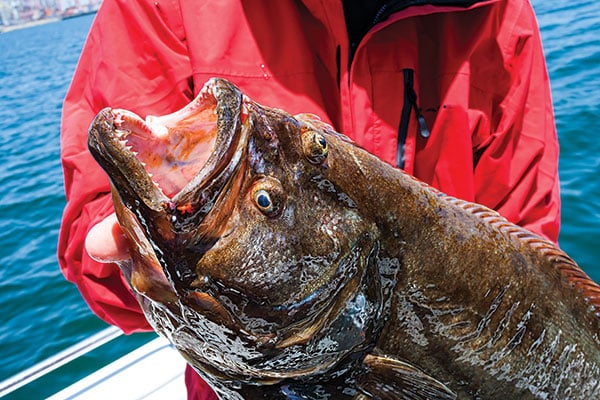
thumb halibut
The violent head shakes and solid resistance left no doubt. We had hooked a big California halibut. As my son, Joshua, slowly eased the fish upward, its mottled-brown topside appearing like an apparition in the depths, its impressive size left me temporarily frozen in amazement.
“Get the gaff,” Joshua shouted, snapping me back to the job at hand. By the time I returned to the gunwale, the large ’but was within striking range, and I sank the gaff. As the 33-pounder came aboard, our celebration began.
This species of halibut represents one of the most prized targets for anglers along the coast of California from Point Arena to Point Loma. Though not reaching the immense proportions of Pacific (aka Alaskan) halibut, the California halibut grows to 40 pounds or more, with the California state record (set in 2011) now holding at 67 pounds, 4 ounces.
One of the most effective techniques to emerge in recent years for catching this species is a trolling method known as bounce-balling.
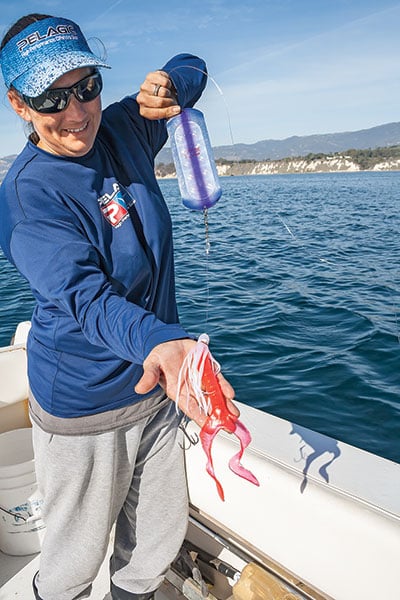
Accidental Discovery
“It’s not really new,” says Santa Barbara Harbor-based Capt. David Bacon, who targets big halibut for guests aboard his 28-foot Wave Walker, with his daughter, Capt. Tiffany Vague, as mate. “Commercial fishermen found out about it accidentally years ago.”
Salmon trollers along the California coast found that their lines near the bottom were hooking a fair number of halibut, according to Bacon. “So some trollers started targeting halibut, and that’s how the technique developed,” he explains. Bacon perfected his techniques while fishing with commercial trollers more than 20 years ago, and then later adapted the same methods to his recreational charters.
“While it takes practice to get it right, there is no technique more consistently effective for catching big California halibut than bounce-balling,” says Bacon, who has caught a number of fish in the 30-pound range, as well as halibut approaching 40 pounds.
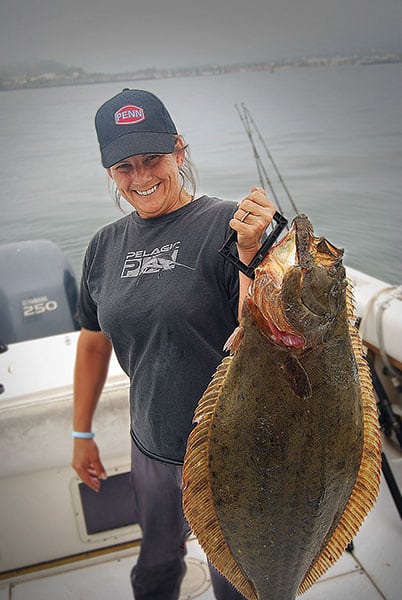
Trolling Concept
Bounce-balling is an orchestrated blend of boat speed and the amount of line you have out that results in the ball bouncing on the bottom two to three times per minute, according to Bacon. While no one has interviewed a halibut on the subject, the reasoning holds that the occasional thump of the weight in sand or mud attracts attention of nearby flatfish, which then follow the pulsating dodger to investigate. Spying the lure swimming tantalizingly behind, it pounces on the easy meal.
Bacon hesitates when it comes to specifying trolling speed. “Boat speed can be affected by wind or current, but it’s really the lure speed through the water that’s critical,” he explains. “I look at the rod-tip action to tell me if boat speed is correct.”
With conventional outfits spooled with 50-pound braid positioned in the gunwale rod holders, Bacon interprets the state of the trolling rigs. “If the tips of the seven-foot rods pulsate smoothly, the dodger is swimming correctly side to side, and if I see the tip spring upward every 20 to 30 seconds, I know the weight is bouncing on the bottom at the correct intervals,” he says.
Generally speaking, speeds range from 11/2 to 21/2 knots, depending on the size of the dodger and lure, says Bacon. “Think in terms of walking speed.”
The amount of line out also plays into this. You want just enough to bounce on the bottom occasionally. Too much line leaves the weight dragging along the bottom, evidenced by the rod tip jerking up and down erratically. On Wave Walker, first mate Vague continually monitors and adjusts lines, usually two, to keep the rigs in the strike zone. Communication between the mate and captain becomes critical as they coordinate their efforts.
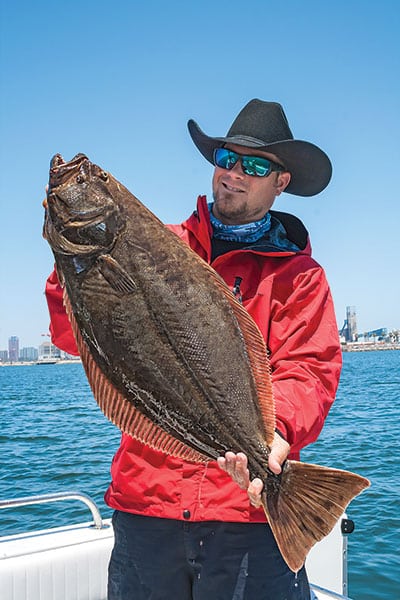
Lure Selection
Bacon employs an array of lures, but one of the most trusted aboard Wave Walker (and among most commercial fishermen) is a 6-inch hoochie skirt, such as those offered by Best of Big Game. These are prerigged with a “gumpuckie” in the head (to keep its shape) and two hooks — a Daiichi 2/0 octopus hook forward and a 1/0 treble stinger — on 50-pound-test fluorocarbon leader. The hoochie skirt slides on the leader to accommodate the addition of a natural bait (such as a dead squid) or a soft-plastic bait under the skirts.
Vague likes to run two hoochie skirts — one inside the other for extra bulk, often inserting a 4¼-inch glow-in-the-dark skirt inside a 6-inch purple-haze skirt.
While hoochies have no action of their own, the dodger ahead of it imparts a side-to-side swimming motion. Consequently, the leader between the lure and dodger should be relatively short, about 15 to 18 inches.
Another lure that Bacon and Vague have found effective is the 5-inch Sand Dab from Kustom Kraft. This soft-plastic flatfish imitation is typically rigged with a single 6/0 Owner Aki Twist hook protruding from the back, so the artificial swims just like a sand dab or flounder swims.

Halibut Water
While California halibut inhabit water as deep as 200 feet, bounce-balling usually proves ineffective at such depths, and so Bacon restricts his trolling depths to 20 to 100 feet.
“I fish mud and sandy bottom along the Santa Barbara coast and the Channel Islands, sampling depths until I catch a fish,” Bacon explains. This is a patience game, with a good deal of prospecting. Bacon has learned over the years that each legal halibut (minimum 22 inches) requires about five hours of bounce-ball trolling time.
Once you hook a fish, you often find others. “A lot anglers keep moving along after they catch a fish,” Bacon says. “I like to troll over the same spot to see if there are other fish around.”
Bacon’s method has been confirmed by his own success, and by reports from divers, who have observed male halibut in the 10- to 20-pound range surrounding a single large female in the 30- to 50-pound range. “It’s not unusual to hook three or four fish in the same 50 square feet,” Bacon says.
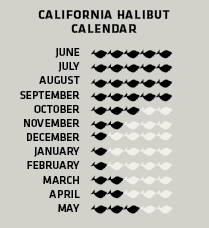
Hooking Up
Recognizing a bite while bounce-balling is usually simple. The rod bows over hard as a halibut inhales the lure. However, not all bites are quite as obvious.
“Sometimes a halibut eats the lure but keeps swimming at our trolling speed,” he says. “The only indication of a bite is that the rod loads up a bit more.” If you suspect that, pick up the rod and set the hook, because over half the time, there’s a fish on.
Avoid pressuring hooked fish too much. Many times you can ease it within gaffing range by applying steady but gentle pressure. Refrain from pumping the fish, but rather wind steadily, as pumping might trigger a violent head shake that rips the hook loose.
Once you’ve landed a big California halibut using this technique, you’ll be in the bounce-ball game for life.









